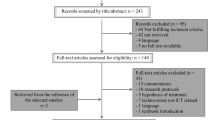Abstract
Study Design: Prospective cohort study with 18-month follow-up. Objective: To investigate if long-term sick listed persons’ own predictions of their future return to work (RTW) have an impact on their RTW when controlling for other established factors. Method: Postal questionnaires at baseline were sent to persons who had been on sick leave for more than 90 days, and were employed in five municipalities and four county councils in Sweden. A follow-up regarding their RTW was performed 18 months later. Results: After 18 months 135 out of 508 persons (27%) had returned to work, full or part-time. In a multivariate logistic regression, the sick listed persons’ own prediction of their RTW proved to be highly significant (OR=8.28, 95% CI: 3.31–20.69). Only six out of 132 persons with a negative view of their RTW did return to wok. Other predictive factors that were found for RTW were: being on sick leave for a period of less than 1 year (OR=2.09, 95% CI: 1.19–3.67), having less pain than persons in the quartile with most pain (OR=2.65, 95% CI: 1.21–5.81), perceiving that one was welcome back to work (OR=1.98, 95% CI: 1.10–3.58), and being under 55 years of age (OR=2.37, 95% CI: 1.07–5.23 for age between 45 and 54 years and the same trend for age below 45 years OR=1.85, 95% CI: 0.82–4.20). Conclusion: Persons with a positive prediction should get help to realise their potential for RTW. Offering traditional rehabilitation measures to a person with a negative prediction of his/her RTW, could be a waste of resources if done ahead of improving self-confidence and view of what is possible. The problems in this group might decrease or be easier to handle if decisions about the future are taken within a year.

Similar content being viewed by others
References
Krause N, Frank J, Dasinger L, Sullivan T, Sinclair S. Determinants of duration of disability and return-to-work after work-related injury and illness: Challenges for future research. Am J Ind Med 2001;40:464–84.
McIntosh G, Frank J, Hogg-Johnson S, Hall H, Bombardier C. Low back pain prognosis: Structured review of the Literature. J Occup Rehabil 2000;10(2):101–15.
Franche R-L, Krause N. Readiness for return to work following injury or illness: Conceptualizing the interpersonal impact of health care, workplace, and insurance factors. J Occup Rehabil 2002;12(4):233–56.
Krause N, Dasinger L, Deegan L, Rudolph L, Brand R. Psychosocial job factors and return to work after compensated low back injury: A disability phase-specific analysis. Am J Ind Med 2001;40:374–92.
Dasinger L, Deegan L, Brand R, Rudolph L. Physical workplace factors and return to work after compensated low back injury. J Occup Environ Med 2000;42(3):323–33.
Friesen M, Yassi A, Cooper J. Return-to-work: the importance of human interactions and organizational structures. Work 2001;17(1):11–22.
Baril R, Clarke J, Friesen M, Stock S, Cole D, Group tW-R. Management of return-to-work programs for workers with musculoskeletal disorders: A qualitative study in three Canadian provinces. Soc Sci Med 2003;57:2101–14.
Mondloch M, Cole D, Frank J. Does how you do depend on how you think you'll do? A systematic review of the evidence for a relation between patients´ recovery expectations and health outcomes. CMAJ 2001;165(2):174–9.
Cole D, Mondloch M, Group EPM. Listening to injured workers: How recovery expectations predict outcomes? Can Med Soc J 2002;166:749–54.
Marhold C, Linton S, Melin L. Identification of obstacles for chronic pain patients to return to work: Evaluation of a questionnaire. J Occup Rehabil 2002;12(2):65–75.
Sandström J, Esbjörnsson E. Return to work after rehabilitation: The significance of the patient's own prediction. Scand J Rehabil Med 1986;18(1):29–33.
Beecher H. The powerful placebo. JAMA 1955;159:1602–6.
Benight C, Bandura A. Social cognitive theory of posttraumatic recovery: the role of perceived self-efficacy. Behav Res Ther 2004;42(10):1129–48.
Heijbel B, Josephson M, Jensen I, Vingård E. Employer, insurance, and health system response to long-term sick leave in the public sector: Policy implications. J Occup Rehabil 2005;15(2):149–58.
Von Korff M, Ormel J, Keefe F, Dworkiin S. Grading the severity of chronic pain. Pain 1992;50:133–49.
Bloch F, Prins R. Who returns to work and why? A six country study on work incapacity and reintegration. New Brunswick New Jersey: Transaction Publisher; 2000.
Berglind H, Gerner U. Motivation and return to work among the long-term sicklisted: An action theory perspective. Disabil Rehabil 2002;24(14):719–26.
van der Weide W, Verbeek J, van Dijk F. Relation between indicators for quality of occupational rehabilitation of employees with low back pain. Occup Environ Med 1999;56(7):488–93.
Anema J, Van Der Giezen A, Buijs P, CVan Mechelen W. Ineffective disability management by docotrs is an obstacle for return to work: A cohort study on low back pain paitients sicklisted for 3–4 months. Occup Environ Med 2002;59(11):729–33.
Nordqvist C, Holmqvist C, Alexanderson K. Views of laypersons on the role employers play in return to work when sick-listed. J Occup Rehabil 2003;13(1):11–20.
Dellve L, Lagerström M, Hagberg M. Rehabilitation of home care workers: supportive factors and obstacles prior to disability pension due to musculoskeletal disorders. J Occup Rehabil 2002;12(2):55–64.
Krause N, Dasinger L, Neuhauser F. Modified work and return to work: a review of the literature. J Occup Rehabil 1998;8(2):113–39.
van Duijn M, Miedema H, Elders L, Burdorf A. Barriers for early return-to-work of workers with musculoskeletal disorders according to occupational health physicians and human resource managers. J Occup Rehabil 2004;14(1):31–41.
Kenny D. Employers’ perspectives on the provision of suitable duties in occupational rehabilitation. J Occup Rehabil 1999;9(4):267–76.
Acknowledgements
We are grateful to Marianne Ekdahl for her work with the data collection. We would also like to express our gratitude to Christian Garheden for his help with the computer technology. This study was supported by grants from the AFA Insurance Co, Sweden.
Author information
Authors and Affiliations
Corresponding author
Rights and permissions
About this article
Cite this article
Heijbel, B., Josephson, M., Jensen, I. et al. Return to work expectation predicts work in chronic musculoskeletal and behavioral health disorders: Prospective study with clinical implications. J Occup Rehabil 16, 169–180 (2006). https://doi.org/10.1007/s10926-006-9016-5
Published:
Issue Date:
DOI: https://doi.org/10.1007/s10926-006-9016-5




